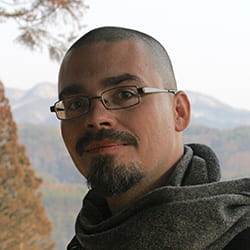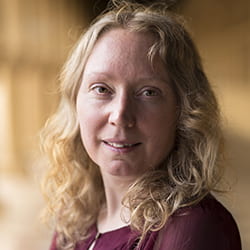Jesse LeFebvre - January 11, 4:30pm, Common Room
 Jesse LeFebvre
Jesse LeFebvre
Ph.D. candidate, East Asian Languages and Civilizations, Harvard University
The Antifragile Hasedera Kannon: Disaster, Revitalization, and Karma in Medieval Japan
Wednesday, January 11, 4:30pm, Common Room
Abstract: Buddhism is often described as a religion that embraces the impermanence and inevitable cessation of all things and yet, paradoxically, this acceptance of impermanence has imbued certain historical manifestations of Buddhism with flourishing sustainability—especially in the face of disaster. One dramatic example of such flourishing comes from the medieval Japanese context where over the course of eight centuries of repeated disaster one of Japan’s most influential temples, Hasedera, fostered the development of a culture that was not merely resistant to disaster’s effects but thrived in the wake of disaster. The site’s “antifragility”—that is, its ability to thrive and grow when exposed to volatility, randomness, disorder, and stressors—transformed the very meaning of disaster itself. Ultimately, destruction became the language by which the Hasedera Kannon was believed to express her will and, as such, disaster was also believed to be the skillful means by which this bodhisattva compassionately intervened in the karmic destinies of individuals, society, Buddhist institutions, and politics in order to generate soteriological opportunities that also served as a catalyst for temple restoration efforts at Hasedera and throughout Japan.
Bio: Jesse LeFebvre is a PhD Candidate in the Department of East Asian Languages and Civilizations at Harvard University. He received a BA in History from the University of Minnesota, a BA in Buddhist Studies from Shuchiin University in Kyoto, Japan, and an MA in Japanese Religion from the University of Hawaii. He specializes in the medieval and modern religious culture and history of Japan with a special interest in Buddhism, religious cultures of disaster, and contemporary Japanese Christianity within the context of “nonreligiousness.”
Mimi Chusid - February 8, 4:30pm, Common Room
 Mimi Chusid
Mimi Chusid
Assistant Professor, Division of Art History, University of Washington
Saving the Dead: Women, Buddhism, and Images of Hell in Japanese Religious Art and Practice
Wednesday, February 8, 4:30pm, Common Room
In Japan, Buddhist conceptions of hell have long served as fertile ground for the creation of fantastic imagery that brings the unknown to life. Scholars have noted that these illustrations often mirror the vivid descriptions of postmortem tortures found in The Essentials of Rebirth (Ōjōyōshū), a text completed in 985 by the monk Genshin that commanded a wide elite readership in the following centuries. A fourteenth-century set of paintings preserved in the Idemitsu Museum of Arts however complicates this assertion and calls into question the relationship between The Essentials and pictorial representations of hell. Even though inscriptions quoting this manuscript are found in four places throughout paintings, many of the pictured scenes do not, in fact, have corresponding textual descriptions. In this talk, I aim to develop a framework for understanding the Idemitsu paintings relative to the people who produced and used them. By investigating how these images operated within the purviews of artists, patrons, and practitioners—the three groups of people responsible for their production and reception—I arrive at unexpected conclusions, including that the Idemitsu paintings were produced for the salvation of women, and for deceased mothers in particular.
Bio: Miriam (Mimi) Chusid specializes in premodern Japanese Buddhism and its visual culture. Her interests include relationships between art, ritual, and text; the role of women in the production and reception of religious images; Buddhist materialities; and the place of conservation in art historical inquiry. She is currently an assistant professor at the University of Washington and is completing a book manuscript that examines the emergence in the thirteenth century of pictures of Buddhist hell used in rituals to benefit the dead.
Stephan Licha - February 15, 4:30pm, Common Room
 Stephan Licha
Stephan Licha
Faculty member, Department of Japanese Studies, University of Heidelberg
Variable Incarnations – Buddhist Modernism and the Materiality of Awakening
Wednesday, February 15, 4:30pm, Common Room
Abstract: When Japanese Buddhists first arrived in Europe in the eighteen seventies to investigate its civilizational and religious circumstances, they accosted their native informants with the demand to be taught “scientific religion.” This episode suggests that no matter how one may wish to define the modern categories of “Buddhism” or “religion,” their global emergence from the latter half of the nineteenth century onwards is inextricably bound to the encounter with the natural sciences and their often radically materialistic and secularist claims.
Whereas previous scholarship has often emphasized the invention of “Buddhism” as part of an Orientalist regime and its strategic appropriation by local actors, this lecture will argue that the notion of “Buddhism as the Eastern world religion” also served as a viral vector through which Buddhist traditions could reproduce their own indigenous concerns und soteriological claims in a newly globalized discursive space. As such, they were active contributors to the formation of Buddhist modernism and, in turn, modern “religion.” The lecture will conclude by reflecting on the contributions that the study of Japanese Buddhism can make to the project of a global history of religion.
Bio: Stephan Kigensan Licha is a faculty member in the Department of Japanese Studies at the University of Heidelberg. He received his PhD from SOAS in 2012 and specializes in the intellectual history of Japanese Buddhism, with an emphasis on the interactions between the pre-modern tantric, Tendai, and Zen traditions, and the global history of Buddhist modernism in the late 19th and early 20th centuries. He has published widely on these topics, and his monograph, “Esoteric Zen: Zen and the Tantric Teachings in Premodern Japan” is forthcoming from Brill.
Michaela Mross - February 22, 4:30pm, Common Room
 Michaela Mross
Michaela Mross
Assistant Professor, Department of Religious Studies, Stanford University
Praising the Patriarchs: Lay Buddhist Choirs in Postwar Sōtō Zen
Wednesday, February 22, 4:30pm, Common Room
Abstract: In the 1950s, Sōtō reformers invented a new style of chanting Japanese hymns, which they named Baikaryū (lit., lineage of plum blossoms). Other Buddhist schools had already founded hymn chanting lineages in the early 20th century. When Sōtō reformers tried to rejuvenate their religion after WWII, they used these as models to create their own style of hymn chanting. This practice soon became very popular among lay devotees, especially women. Even today, the annual meeting of the Baikaryū, attended by around 10,000 laypeople, is the largest regular event that the Sōtō Zen school hosts.
This paper examines how different groups of practitioners interpret the practice of hymn chanting. In the official publications of the Baikaryū, clerics promote an “ orthodox” interpretation of singing Buddhist hymns, arguing that the singing is an expression of the realization of buddhahood in the same way as seated meditation. Interviews with lay practitioners suggest that some devotees also interpret the singing through this Sōtō Zen lens but others do not: for some it is a practice offering salvation, for others it offers grief care, and for others it is a form of recreation and leisure providing a social support network. Thus, we find a multitude of views and interpretations that inform the singing of Buddhist hymns, highlighting the multivocality within contemporary Sōtō Zen.
Bio: Michaela Mross is assistant professor of Religious Studies at Stanford University. She specializes in Japanese Buddhism, with a particular emphasis on Sōtō Zen, Buddhist rituals, sacred music, as well as manuscript and print culture in premodern Japan. Her first book, Memory, Music, Manuscripts: The Ritual Dynamics of Kōshiki in Japanese Sōtō Zen (University of Hawai’i Press, 2022) explores the history and performance practice of the kōshiki rituals performed exclusively by clerics and suggests that we need to understand Zen as an embodied practice with a rich sonic dimension. She is currently working on a monograph on vernacular hymns and lay Buddhist choirs in contemporary Sōtō Zen.